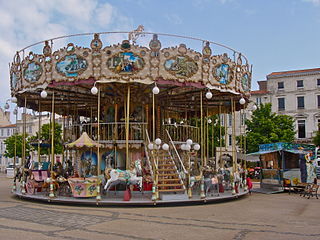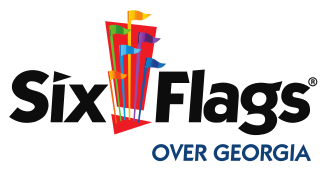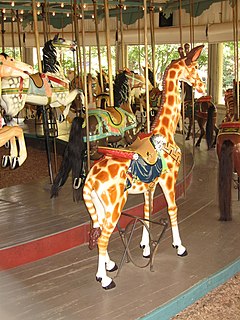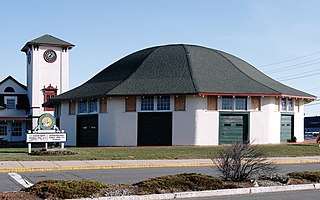
A carousel, merry-go-round, or hurdy-gurdy is a type of amusement ride consisting of a rotating circular platform with seats for riders. The "seats" are traditionally in the form of rows of wooden horses or other animals mounted on posts, many of which are moved up and down by gears to simulate galloping, to the accompaniment of looped circus music.

Six Flags AstroWorld, also known simply as AstroWorld, was a seasonally operated amusement park in Houston, Texas. Owned and operated by Six Flags, the park was situated between Kirby Drive and Fannin Street, directly south of I-610. The park opened on June 1, 1968, and was developed originally and constructed as part of the Astrodomain, the brainchild of local philanthropist and former Houston mayor Roy Hofheinz, who intended it to complement the Astrodome. The Hofheinz family sold AstroWorld to Six Flags in 1978.

Six Flags Over Texas is a 212-acre amusement park located in Arlington, Texas, east of Fort Worth and west of Dallas. It is the first amusement park in the Six Flags chain, and features themed areas and attractions. The park opened on August 5, 1961, following a year of construction and an initial investment of US$10 million by real estate developer Angus G. Wynne, Jr.

Six Flags Over Georgia is a 290-acre (1.2 km2) theme park located in unincorporated Cobb County, Georgia, United States, near Austell. Opened in 1967, it is the second park in the Six Flags chain following the original Six Flags Over Texas, which opened in 1961.

Playland, often called Rye Playland and also known as Playland Amusement Park, is an amusement park located in Rye, New York, along the Long Island Sound. Built in 1928, the 280-acre (110 ha) park is owned by the Westchester County government. Beginning with the 2018 season, Standard Amusements LLC has been contracted to operate the park.

The swing ride or chair swing ride is an amusement ride that is a variation on the carousel in which the seats are suspended from the rotating top of the carousel. On some versions, particularly on the Wave Swingers, the rotating top of the carousel also tilts for additional variations of motion.

Columbia Carousel is a pair of double-decker carousels at Six Flags Great America and California's Great America. Both parks were originally built by the Marriott hotel chain as sister properties but they were later sold off and are presently owned by Six Flags and Cedar Fair, respectively. To this date, Carousel Columbia is the world's tallest carousel.

The Rotor is an amusement ride designed and patented by German engineer Ernst Hoffmeister in 1948. The ride was first demonstrated at Oktoberfest 1949, and was exhibited at fairs and events throughout Europe, during the 1950s and 1960s. The ride still appears in numerous amusement parks, although travelling variants have been surpassed by the Gravitron.

Viper was a steel roller coaster located at Six Flags AstroWorld in Houston, Texas. Manufactured by Anton Schwarzkopf, the Looping Star model opened in 1989. It consisted of a single loop and was demolished with the closing of Six Flags AstroWorld on October 30, 2005. It had previously operated at Six Flags St. Louis, where it was known as Jet Scream from 1981 to 1988.
The Ameri-Go-Round was the name given to two carousels, one at each of Marriot's Great America amusement parks, Six Flags Great America in Gurnee, Illinois and California's Great America in Santa Clara, California.
Rockaways' Playland was an amusement park that operated from 1902 to 1987 in Rockaway Beach in Queens, New York City. Bounded by Beach 97th and Beach 98th Streets between Rockaway Beach Boulevard and the Rockaway Beach and Boardwalk, Rockaways' Playland was created in 1902 by roller coaster designer LaMarcus Adna Thompson. By 1903 was a ferry dock not far from the park, making it more convenient to reach than some of the competing amusement parks. It was sold in 1927 to Robert Katlin who added amenities such as a gym and swimming pool, and the following year to A. Joseph Geist who achieved greater success than the previous owners. Between 1928 and 1970, Rockaways' Playland was extremely successful, drawing 175 million visitors. It closed in 1987 due to a sharp increase in the price of insurance.
The C. W. Parker Carousel is a carousel built in 1912 currently operating in the Burnaby Village Museum at Deer Lake Park in Burnaby, British Columbia. The carousel was built by the C. W. Parker Company and is also known as the Parker #119 and the Burnaby Centennial Parker Carousel. The carousel was the 119th such machine built by the C. W. Parker Company, earning it its "Parker #119" nickname. The carousel contains 41 horses and operates at a pavilion known as the Don Wrigley Pavilion located at one of the museum's two entrances, earning the entrance the name "Carousel Entrance".

The Pullen Park Carousel is a classic wood carousel at Pullen Park in Raleigh, North Carolina. Built in 1900, the carousel contains 52 hand-carved basswood animals, 2 chariots, 18 large gilded mirrors and canvas panels and a Wurlitzer #125 band organ made in 1924 by the Rudolph Wurlitzer Company of North Tonawanda, New York.

The Cass County Dentzel Carousel, formerly known as the Spencer Park Dentzel Carousel and also known as the Riverside Park Dentzel Carousel or Logansport Carousel, is a historic carousel in Riverside Park of Logansport, Indiana. Built by the Dentzel Carousel Company, probably by 1900, it is one of the company's oldest surviving menagerie-style carousels, with animals likely hand-carved by George Dentzel. It was declared a National Historic Landmark in 1987.

Broad Ripple Park Carousel is an antique carousel in The Children's Museum of Indianapolis. It was installed in 1917 at an amusement park near the White River in Indianapolis, Indiana, where it remained until the building housing it collapsed in 1956. The ride's mechanism was destroyed, but the animals were relatively unscathed and put into storage by the park's owners, the Indianapolis Department of Parks and Recreation. The animals were carved by the Dentzel Carousel Company some time before 1900 but were assembled by the William F. Mangels carousel company, which also supplied the engine powering the ride.

The Paragon Park Carousel is a historic carousel at 1 Wharf Avenue in Hull, Massachusetts. Built in 1928 by the Philadelphia Toboggan Company, it is one of the state's only surviving four-wide carousels, and is the only surviving element of the Paragon Park amusement park. The carousel was listed on the National Register of Historic Places in 1999.

The Circus Building is an exhibit building at Shelburne Museum in Shelburne, Vermont. It houses a collection of circus posters, Gustav A. Dentzel Carousel animals, and elaborately carved miniature circuses, including those by Roy Arnold and Edgar Kirk.

The G.A. Dentzel Company was an American builder of carousels in Philadelphia, Pennsylvania, United States, in the late 19th and early 20th centuries.














